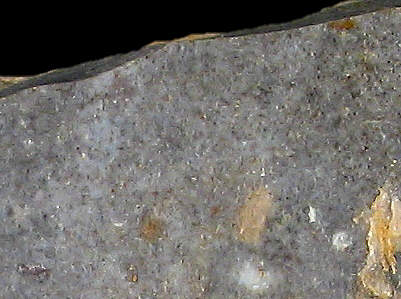
Foto: Jehanne Féblot-Augustins, 2005.
- Balme à Juliette 1
Sampled sites:
| Material name: | Bj4a |
| Synonyms: | N/A |
| Material (geologic): | Middle Jurassic (Late Bajocian) flint/chert. |

Foto: Jehanne Féblot-Augustins, 2005. |
Sampled sites:
|
| Mode of occurrence: | Occurring in continuous beds 5 to 6 cm thick, highly jointed, jutting out from the compact light brownish grey to light reddish tan limestone. Upper layers of an outcrop at the top of a cliff face. |
| Cortex: | Fresh, rough, grey-white, 1 cm thick, transition sharp. |
| Colour: | Blue-grey (N6). |
| Pattern: | Featureless, rare pale-coloured specks. |
| Appearance: | Homogeneous material, although highly jointed, dull and opaque, moderately smooth, medium to fine-grained. |
| Structure: | No particular structure. |
| Texture: | Wackestone. |
| Matrix: | Opaque. |
| Grains: | 30 to 40 %, white, pale yellow, ochre, black, rounded with high to low sphericity; main grain size 100 µ, with a few grains ranging between 250 and 1000 µ. |
| Grain composition: | Very numerous sponge spicules and foraminifera (frequent black "ghosts" outlined by impurities), pelecypod fragments, serpulids, dispersed entrochi and ooliths, rare pellets, rare Cyclostoma bryozoans. |
| Further information: | Click here for the original French description (opens in a new window), or here for more information on the attributes used in the description (use your browser's "BACK"-button to return here). |
| Citing: | Information on citing this page can be found here. |
| Locality: | Ambérieu-en-Bugey / Les Balmeaux - Balme à Juliette 1, France, Ain department |
| Synonyms: | Sampling site Bugey 4 after Féblot-Augustins |
| Geographical description: | The sample was taken from the upper flint-layers at the top of a cliff approx. 1 kilometre to the east of Vareille, a hamlet at the eastern side of Ambérieu-en-Bugey. For a more precise explanation of the local situation, see the description under Bt4 |
| Geographical co-ordinates: |
east/x 836.4 north/y 2111 (Lambert zone II, NTF)
This corresponds roughly with |
| Co-ordinate precision: |
The coordinates given were taken from a large-scale map, and are within 50 metres of the actual exposure. The latitude/longitude coordinates are a direct transformation of these data on WGS84 and are accurate to the same level. The high precision to the second is given to prevent the introduction of a rounding-error. The location can be found on the 1:25 000 topographical map sheet 3130 E of the French Institut Géographique National. |
| Geology: |
According to the geological map, the parent-rock belongs to unit J1c of late Bajocian age. Map of all sampled localities of Bajocian flint in the Bugey (PDF, 190 KB, opens in new window). |
| Type of source: | Primary. |
| Other types of flint: | In the same exposure the middle and lower banks of flint consist of the coarser Late Bajocian varieties Bj4b and Bj4c. |
thumb.jpg) Foto: Jehanne Féblot-Augustins, 2005 |
thumb.jpg) Foto: Jehanne Féblot-Augustins, 2005 |
| Last modified on: November 15, 2005 |
Contents primarily by: Jehanne Féblot-Augustins |
Comments to: |